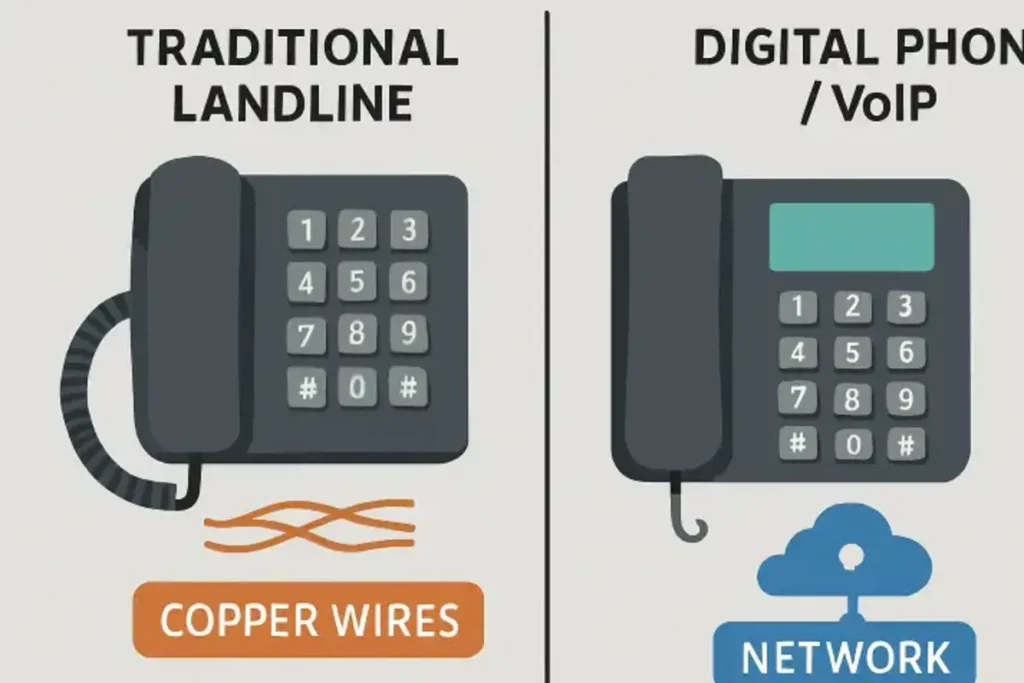Key Takeaways
- Legacy POTS (Plain Old Telephone Service) lines are being retired across industries due to rising costs and aging infrastructure.
- Modern alternatives offer cost savings, enhanced features, and improved reliability.
- Transitioning from POTS demands careful planning and consideration of regulatory, emergency, and operational needs.
- Real-world data and current trends highlight the urgency for businesses to explore digital voice technologies.
POTS Lines: A Brief Overview
For decades, Plain Old Telephone Service (POTS) lines defined the standard for business voice communications. Operating over traditional copper wiring, POTS lines were prized for their simplicity and resilience, with minimal hardware required for operation. Yet, as digital communications infrastructure surges ahead—regularly evolving to meet the demands of remote work and integrated systems—the ongoing maintenance and reliability of analog technology are coming under increased scrutiny across various sectors.
The urgent need to replace POTS lines arises as more service providers discontinue support for legacy analog networks. The outdated copper-based infrastructure not only faces the inevitability of aging out but also creates complications for repair and scalability as demand for modern connectivity grows. More organizations are evaluating their voice infrastructure and prioritizing upgrades to digital solutions that can deliver reliability, savings, and new features.
Driving Forces Behind the Shift
The push to modernize voice infrastructure stems from several industry-wide trends. Most notably, the maintenance costs of sustaining POTS lines are on a rapid climb. Replacement parts and skilled labor for analog technology are increasingly difficult to find, thereby inflating expenses. Additionally, POTS lines lack support for advanced communication features that have become standard in today’s business environment, such as mobile device integration, unified messaging, and advanced call tracking.
According to the Federal Communications Commission (FCC) and industry leaders, telecom providers have committed massive investments in fiber optic and IP-based networks, which are phasing out copper lines entirely. The industry-wide transition is not simply a matter of preference but an essential step in future-proofing critical communications, as analog systems can no longer keep pace with the rapid pace of digital innovation.
Cost Considerations and Business Impact
With legacy POTS (Plain Old Telephone Service) lines, businesses are facing monthly charges that often exceed $100 per connection, a significant expense that quickly scales upward for organizations with multiple locations. In contrast, digital voice solutions offer businesses substantial cost savings, delivering a wide array of advanced features for a fraction of the cost of traditional lines. According to a 2023 report by the Wall Street Journal, sectors such as retail, healthcare, and security are rapidly fast-tracking their migration plans to digital voice technology precisely because of these escalating costs and the benefits it provides. In many cases, transitioning from analog to digital voice communication not only transforms budget allocation but also enables companies to reinvest those savings into areas like growth, innovation, and improved customer service, thereby gaining a competitive edge in their respective markets.
Advantages of Digital Voice Solutions
Adopting digital voice technology isn’t just about reducing expenses—it opens doors to powerful new tools. Modern digital phone systems feature call analytics, voice-to-email transcription, automated attendants, easy scalability, and seamless integration with critical business software. These advanced features are increasingly essential for organizations managing hybrid or distributed teams and those seeking to enhance client service through improved communication.
Along with expanded capabilities, digital solutions tend to deliver superior reliability and disaster recovery options. With cloud-based infrastructure and built-in redundancy, downtime risks are minimized, providing organizations with peace of mind when continuity matters most.
Ensuring Reliable Emergency Communications
A particularly crucial consideration during POTS replacement involves systems that affect safety and security—such as elevator phones, fire alarms, and emergency call boxes. Many of these still depend on analog lines, creating compliance and operational challenges during the transition. Companies must evaluate and test digital alternatives thoroughly to ensure they meet federal, state, and local regulations for emergency reliability. Opting for solutions with battery backup, power-over-ethernet, or cellular failover mechanisms can provide the resilience and dependability required for life-safety systems, especially during power outages or disaster events.
Steps To Plan A Successful Transition
- Audit existing lines and systems: Identify all legacy phone lines and understand their role within your business—particularly those serving elevators, alarms, or compliance-sensitive functions.
- Consult with stakeholders: Involve IT, facilities, compliance, and department heads to gather a full picture of critical needs and operational impact.
- Evaluate digital voice options: Assess providers based on features, pricing, uptime guarantees, support, and ease of integration with your current technology stack.
- Test compatibility: Before wide-scale deployment, verify that essential systems (e.g., security panels and elevator phones) function smoothly with digital voice alternatives.
- Develop a phased migration plan: Implement upgrades in stages, incorporating staff training and backup provisions for smooth switchover with minimal disruption.
Challenges and Common Pitfalls
Despite the clear and significant upside potential of adopting digital voice technologies, the journey to fully implementing and integrating these systems is not without its obstacles and challenges. Some organizations, during the initial phases of adoption, encounter unexpected compatibility issues between existing infrastructure and new digital voice platforms. Additionally, failure to thoroughly recognize and assess operational dependencies and requirements during their initial audits can lead to unforeseen outages, disruptions, and inefficiencies. Furthermore, regulatory compliance, especially concerning emergency systems and public safety communications, if not comprehensively addressed and fully accounted for, may expose companies to substantial fines, legal risks, and reputational damage. However, with proactive and strategic planning—grounded in comprehensive stakeholder engagement, detailed risk assessments, and close consultation with experienced telecommunications vendors and industry experts—most of these concerns can be effectively mitigated. Such an approach helps ensure a seamless, smooth, and ultimately successful transition to digital voice, maximizing benefits while minimizing setbacks.
Looking Ahead: Future Trends In Business Communications
The ongoing replacement of POTS lines is just one aspect of a broader change in how organizations communicate. As cloud, AI, and advanced analytics become integral parts of business communication infrastructure, companies that embrace these shifts will benefit from increased agility, efficiency, and improved customer experiences. Keeping a close and attentive eye on the latest updates, announcements, and reports from the Federal Communications Commission (FCC), as well as leading industry reports and analyses, can greatly assist businesses in their strategic planning. This diligent monitoring enables them to anticipate upcoming milestones, technological advancements, and regulatory shifts in the ongoing process of telecom modernization. By staying informed about these developments, businesses are better positioned to make timely, well-informed decisions that will help them adapt to the evolving landscape and capitalize on new opportunities in the telecommunications sector.



